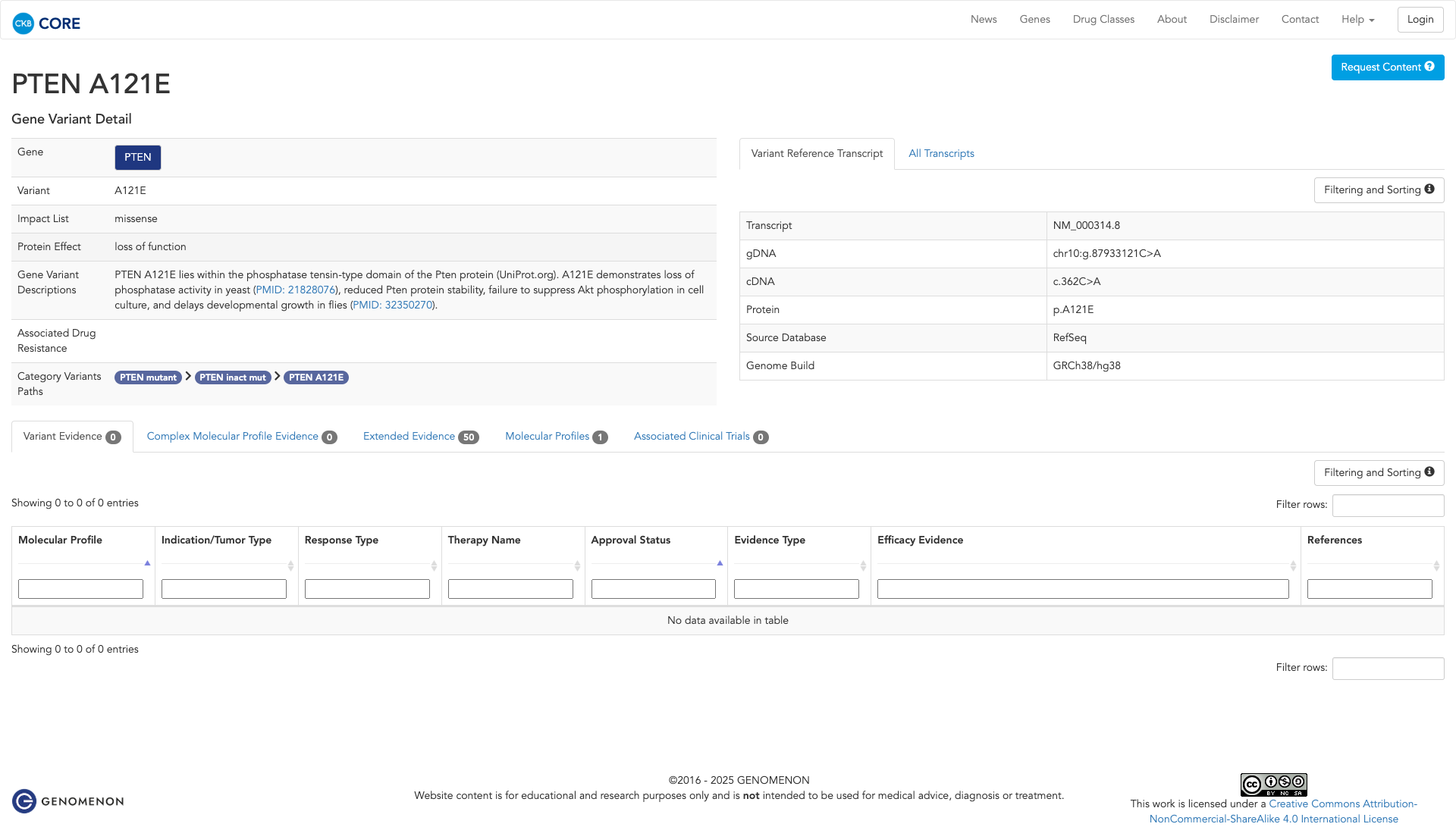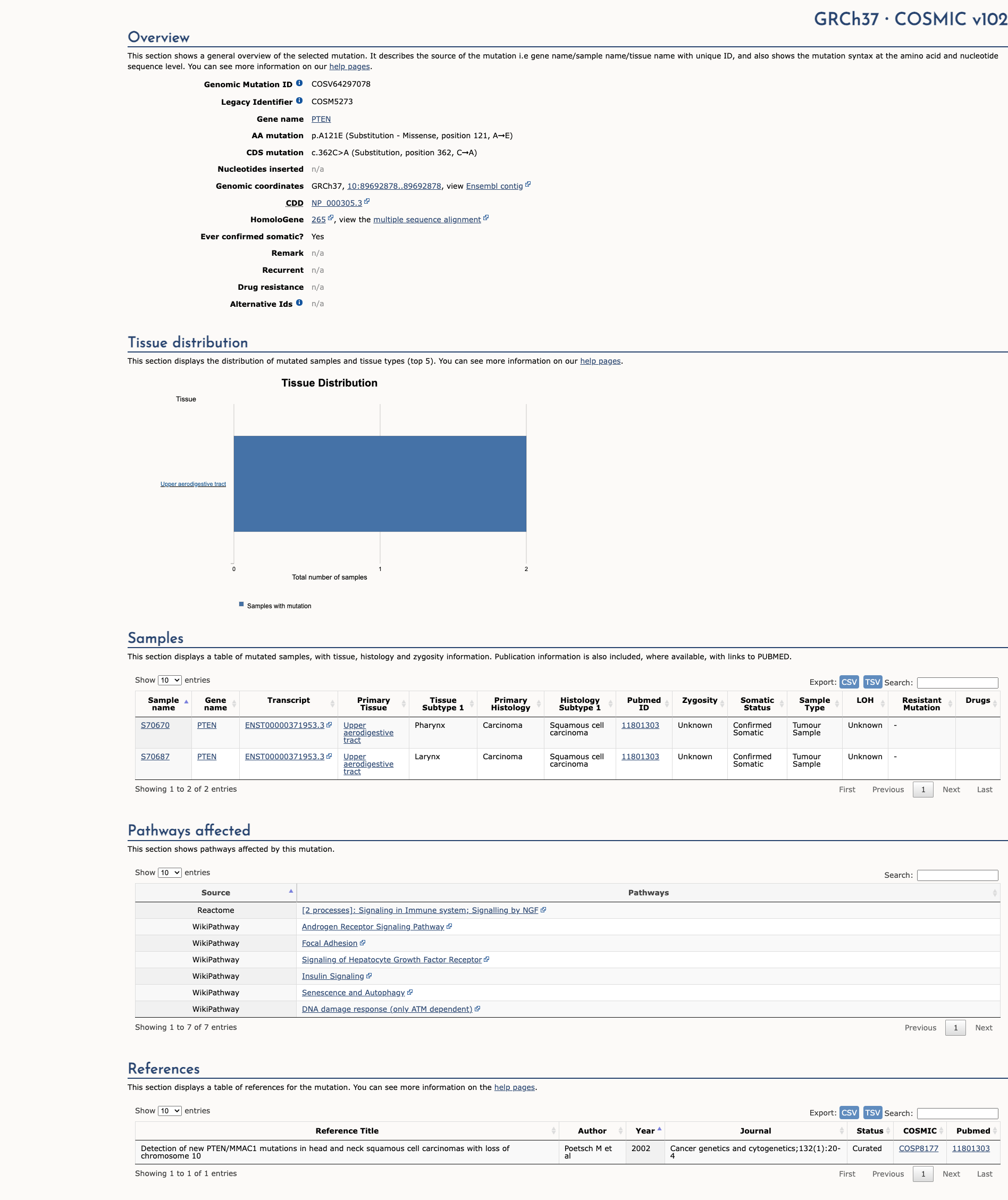PTEN c.362C>A, p.Ala121Glu
NM_000314.8:c.362C>A
COSMIC ID: COSM5273
Pathogenic
The classification as Pathogenic is supported by a PTEN-specific moderate functional criterion (PS3_Moderate), moderate PM5, and supporting PM2, PP3, and PP5, reflecting strong functional loss, absence from controls, computational deleteriousness, and a reputable pathogenic report.
ACMG/AMP Criteria Applied
PS3
PM2
PM5
PP3
PP5
Genetic Information
Gene & Transcript Details
Gene
PTEN
Transcript
NM_000314.8
MANE Select
Total Exons
9
Strand
Forward (+)
Reference Sequence
NC_000010.10
Alternative Transcripts
| ID | Status | Details |
|---|---|---|
| NM_000314.7 | RefSeq Select | 9 exons | Forward |
| NM_000314.5 | Alternative | 9 exons | Forward |
| NM_000314.4 | Alternative | 9 exons | Forward |
| NM_000314.3 | Alternative | 9 exons | Forward |
| NM_000314.6 | Alternative | 9 exons | Forward |
Variant Details
HGVS Notation
NM_000314.8:c.362C>A
Protein Change
A121E
Location
Exon 5
(Exon 5 of 9)
5'Exon Structure (9 total)3'
Functional Consequence
Loss of Function
Related Variants
ClinVar reports other pathogenic variants at position 121: A121P, A121T, A121G
Alternate Identifiers
COSM5273
Variant interpretation based on transcript NM_000314.8
Genome Browser
Loading genome browser...
HGVS InputNM_000314:c.362C>A
Active Tracks
ConservationRefSeqClinVargnomAD
Navigation tips: Use mouse to drag and zoom. Click on features for details.
Clinical Data
Population Frequency
Global Frequency
0.0 in 100,000
Extremely Rare
Global: 0.0%
0%
0.05%
0.1%
1%
5%
10%+
ACMG Criteria Applied
PM2
This variant is not present in gnomAD (PM2 criteria applies).
Classification
1 publications
Likely Pathogenic
Based on 1 submitter review in ClinVar
Submitter Breakdown
1 LP
Pathogenic
Likely Path.
VUS
Likely Benign
Benign
Publications (1)
This variant is considered likely pathogenic. This variant is expected to disrupt protein structure [Myriad internal data]. Functional studies indicate this variant impacts protein function [PMID: 29785012, 32350270].
Clinical Statement
This variant has been reported in ClinVar as Likely pathogenic (1 clinical laboratories).
Functional Impact
Functional Domain
Hotspot Status
Not a hotspot
Domain Summary
This variant is not located in a mutational hotspot or critical domain (0 mutations).
Related Variants in This Domain
ClinVar reports other pathogenic variants at position 121: A121P, A121T, A121G
PM5 criterion applied.
Functional Summary
The PTEN A121E variant has been functionally characterized and demonstrates a damaging effect. It is located in the phosphatase domain of the PTEN protein and results in loss of phosphatase activity, as evidenced by decreased protein activity in yeast. Additionally, this variant reduces PTEN protein stability, fails to suppress Akt phosphorylation in cell culture, and delays developmental growth in Drosophila. These findings indicate a loss of PTEN function and suggest a likely oncogenic effect.
Database Previews
OncoKB

JAX-CKB

Click on previews to view full database entries. External databases may require institutional access.
Computational Analysis
Pathogenicity Predictions
REVEL Score
0.884
0.884
Likely Benign0.0
Uncertain (Low)0.2
Uncertain (Med)0.5
Likely Pathogenic0.75
REVEL scores ≥ 0.75 are strong evidence (PP3)
Predictor Consensus
Pathogenic
PP3 Applied
Yes
Additional Predictors
Pathogenic:
sift: Dpolyphen_prediction: probably_damagingmutationtaster: Dfathmm: Dprovean: Dmetasvm: Dmetalr: Dprimateai: Ddeogen2: D
Benign:
CADD: 6.09
Neutral: Show all
VCEP Guidelines
Applied ACMG/AMP Criteria (VCEP Specific) VCEP Guidelines
PVS1
PVS1 (Not Applied) Strength Modified
According to VCEP guidelines: the rule for PVS1 is “Use PTEN PVS1 decision tree” which applies to null variants causing loss of function. The evidence for this variant shows it is a missense change (c.362C>A, p.A121E) and not a null variant. Therefore, PVS1 is not applied.
PS1
PS1 (Not Applied) Strength Modified
According to VCEP guidelines: the rule for PS1 is “Same amino acid change as a previously established pathogenic variant.” The evidence for this variant shows that p.A121E is novel and no identical amino acid change has been previously established as pathogenic. Therefore, PS1 is not applied.
PS2
PS2 (Not Applied) Strength Modified
According to VCEP guidelines: the rule for PS2 is “De novo (confirmed parentage) in a patient with the disease and no family history.” The evidence for this variant shows no data on parental testing or de novo occurrence. Therefore, PS2 is not applied.
PS3
PS3 (Moderate) Strength Modified
According to PTEN Pre-processing: the finding for PS3_Moderate is “Phosphatase activity ≤ -1.11 per Mighell et al. 2018…score -1.6706 < -1.11.” The evidence for this variant shows multiple well-established in vitro and in vivo functional studies demonstrating loss of PTEN phosphatase activity and stability (yeast assay, Akt phosphorylation, Drosophila model). Therefore, PS3 is applied at Moderate strength.
PS4
PS4 (Not Applied) Strength Modified
According to VCEP guidelines: the rule for PS4 is “Prevalence in affected individuals is significantly increased compared with controls or proband specificity score ≥4.” The evidence for this variant shows no case-control data or proband specificity scores. Therefore, PS4 is not applied.
PM1
PM1 (Not Applied) Strength Modified
According to VCEP guidelines: the rule for PM1 is “Located in a mutational hot spot and/or critical functional domain (residues 90–94, 123–130, 166–168).” The evidence for this variant shows position 121 is outside these defined regions. Therefore, PM1 is not applied.
PM2
PM2 (Supporting) Strength Modified
According to VCEP guidelines: the rule for PM2 is “Absent in population databases or extremely low frequency (<0.00001 in gnomAD).” The evidence for this variant shows it is absent from gnomAD (MAF=0%). Therefore, PM2 is applied at Supporting strength.
PM3
PM3 (Not Applied) Strength Modified
According to standard ACMG guidelines: the rule for PM3 is “Detected in trans with a pathogenic variant for an autosomal recessive disorder.” The evidence for this variant shows no data on trans configuration in a recessive context. Therefore, PM3 is not applied.
PM4
PM4 (Not Applied) Strength Modified
According to VCEP guidelines: the rule for PM4 is “Protein length changes due to in-frame indels in non‐repeat regions or stop-loss variants.” The evidence for this variant shows it is a missense substitution, not an in-frame indel or stop-loss. Therefore, PM4 is not applied.
PM5
PM5 (Moderate)
According to VCEP guidelines: the rule for PM5 is “Missense change at a residue where a different missense change determined to be pathogenic has been seen; BLOSUM62 score equal or less than known variant.” The evidence for this variant shows that a different pathogenic missense at residue 121 has been reported. Therefore, PM5 is applied at Moderate strength.
PM6
PM6 (Not Applied) Strength Modified
According to VCEP guidelines: the rule for PM6 is “Assumed de novo without confirmation of paternity and maternity.” The evidence for this variant shows no de novo data. Therefore, PM6 is not applied.
PP1
PP1 (Not Applied) Strength Modified
According to VCEP guidelines: the rule for PP1 is “Co-segregation with disease in multiple affected family members.” The evidence for this variant shows no family segregation data. Therefore, PP1 is not applied.
PP2
PP2 (Not Applied) Strength Modified
According to standard ACMG guidelines: the rule for PP2 is “Missense variant in gene with low rate of benign missense variation where missense is common mechanism.” The evidence for this variant shows PTEN has both benign and pathogenic missense, so PP2 is not applied.
PP3
PP3 (Supporting)
According to VCEP guidelines: the rule for PP3 is “Multiple lines of computational evidence support deleterious effect; for missense REVEL >0.7.” The evidence for this variant shows REVEL score 0.88 (>0.7) and concordant in silico tools. Therefore, PP3 is applied at Supporting strength.
PP4
PP4 (Not Applied) Strength Modified
According to standard ACMG guidelines: the rule for PP4 is “Phenotype highly specific for a single gene disorder.” The evidence for this variant shows no detailed phenotypic data. Therefore, PP4 is not applied.
PP5
PP5 (Supporting)
According to standard ACMG guidelines: the rule for PP5 is “Reputable source reports variant as pathogenic but evidence not available.” The evidence for this variant shows ClinVar submission by a clinical laboratory classifies it as Likely pathogenic. Therefore, PP5 is applied at Supporting strength.
BA1
BA1 (Not Applied) Strength Modified
According to VCEP guidelines: the rule for BA1 is “Allele frequency >0.00056 in gnomAD.” The evidence for this variant shows MAF=0%. Therefore, BA1 is not applied.
BS1
BS1 (Not Applied) Strength Modified
According to VCEP guidelines: the rule for BS1 is “Allele frequency 0.000043–0.00056 in gnomAD.” The evidence for this variant shows MAF=0%. Therefore, BS1 is not applied.
BS2
BS2 (Not Applied) Strength Modified
According to VCEP guidelines: the rule for BS2 is “Observed as homozygous in healthy individual.” The evidence for this variant shows no homozygous observations. Therefore, BS2 is not applied.
BS3
BS3 (Not Applied) Strength Modified
According to VCEP guidelines: the rule for BS3 is “Well-established functional studies show no damaging effect.” The evidence for this variant shows functional studies demonstrate damaging effect. Therefore, BS3 is not applied.
BS4
BS4 (Not Applied) Strength Modified
According to VCEP guidelines: the rule for BS4 is “Lack of segregation in affected members of families.” The evidence for this variant shows no segregation data. Therefore, BS4 is not applied.
BP1
BP1 (Not Applied) Strength Modified
According to standard ACMG guidelines: the rule for BP1 is “Missense in gene where only truncating variants cause disease.” The evidence for this variant shows missense is an established mechanism in PTEN. Therefore, BP1 is not applied.
BP2
BP2 (Not Applied) Strength Modified
According to VCEP guidelines: the rule for BP2 is “Observed in trans with a pathogenic variant or ≥3 observations in cis.” The evidence for this variant shows no phase data. Therefore, BP2 is not applied.
BP3
BP3 (Not Applied) Strength Modified
According to standard ACMG guidelines: the rule for BP3 is “In-frame indels in repetitive region.” The evidence for this variant shows it is a missense substitution. Therefore, BP3 is not applied.
BP4
BP4 (Not Applied) Strength Modified
According to VCEP guidelines: the rule for BP4 is “Computational evidence suggests no impact (REVEL <0.5).” The evidence for this variant shows REVEL 0.88 (>0.5). Therefore, BP4 is not applied.
BP5
BP5 (Not Applied) Strength Modified
According to VCEP guidelines: the rule for BP5 is “Variant found in case with alternate molecular basis for disease.” The evidence for this variant shows no alternate molecular findings. Therefore, BP5 is not applied.
BP6
BP6 (Not Applied) Strength Modified
According to standard ACMG guidelines: the rule for BP6 is “Reputable source reports variant as benign.” The evidence for this variant shows no benign reports. Therefore, BP6 is not applied.
BP7
BP7 (Not Applied) Strength Modified
According to VCEP guidelines: the rule for BP7 is “Synonymous or intronic variant with no splicing impact.” The evidence for this variant shows it is missense. Therefore, BP7 is not applied.

